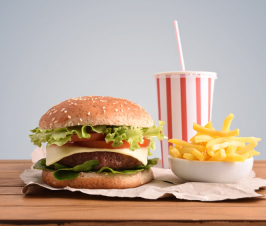Shawn Peters
There’s an ample abundance and inclusion of unhealthy types of food in many peoples’ diets
There is a significant food security concern in Canada, raising the concern of the ability, or inability, for Canadians to access adequate food due to financial limitations.1 There is also an ample abundance and inclusion of unhealthy types of food in many peoples’ diets. That is to say, processed foods are cheap and whole foods are expensive; processed foods are widely available and whole foods can be tough to find.2 As such, it is no big surprise that many of us, when facing financial limitations, choose to purchase processed foods over whole foods.
I would like to present two strategies that work well in my household. My partner and I use these strategies to save money and choose healthy, whole foods. The first is to stock a light pantry with healthy, whole ingredients and the second is to plan a food menu each week. While they may seem simple, and most certainly do not address by any stretch of the imagination the growing food insecurity for many Canadians, it does go a long way to helping her and myself, and could help many individuals, make healthier food choices.
Stock your pantry
The first strategy, stocking a light pantry, allows us the ability to have ingredients on hand so that we can make healthy meals when we’ve forgotten an ingredient for a recipe or have needed to respond to a change in our weekly routine. It does presuppose the ability to put forth the money ahead of time (which I understand is not always possible), but if possible it will save money later on when less food is wasted or thrown away.
A simple pantry might include whole grains (such as brown rice, quinoa, whole grain flours, and pastas), dried beans (lentils and chickpeas), sea vegetables, cooking oils (high and low heat), a few canned tomatoes and beans, plus a few spices and herbs. Also, some good sweeteners (honey, maple syrup, stevia, or coconut sugar/syrup) and snacks (nuts/seeds and dried fruit) are essential. Fresh fruits, vegetables, and specific ingredients are purchased weekly.
Plan Ahead
The second strategy, planning a weekly food menu, allows us to choose a variety of meals each week and to choose whole, healthy ingredients to make them with. It also allows us to plan good leftovers for lunches. Importantly, planning this way allows us to buy only what we need and to waste very little through the week, saving us money and reducing the good food we throw away.
To make a weekly food menu, we use our favourite websites and cookbooks to choose what we would like to eat for the week. We write down each day what we are going to eat for lunch and dinner, while at the same time writing down the ingredients for those meals. We plan out three evenings to cook meals while enjoying the leftovers on the other days. We also plan to make healthy and delicious snacks, knowing that by doing so we will spend less through the week.
Additional Resources
- Recipes – http://www.alive.com/category/food/
- Information – Staying Healthy with Nutrition, by Elson M. Haas, MD
 With an interest in nutrition, I both attended and instructed at the Canadian School of Natural Nutrition in Calgary. I practiced natural nutrition and worked in health food stores for the better part of a decade before I decided to actively pursue naturopathic medicine. The Boucher Institute of Naturopathic Medicine was a natural choice for me and I am loving it. I am deeply passionate about environmental stewardship, intentional communities, and philosophy, including animal rights. Visit me at: https://getwellhere.com/dr-shawn-peters/
With an interest in nutrition, I both attended and instructed at the Canadian School of Natural Nutrition in Calgary. I practiced natural nutrition and worked in health food stores for the better part of a decade before I decided to actively pursue naturopathic medicine. The Boucher Institute of Naturopathic Medicine was a natural choice for me and I am loving it. I am deeply passionate about environmental stewardship, intentional communities, and philosophy, including animal rights. Visit me at: https://getwellhere.com/dr-shawn-peters/
References:
- Enns, G. (2016, March 09). Canada must ‘grow’ its capacity for health and food security. Retrieved March 27, 2016, from http://www.thinkupstream.net/goodfoodpolicy
- Li, T. (2016, February 22). Food bank stats don’t tell the story of food insecurity. Retrieved March 27, 2016, from http://www.thinkupstream.net/foodbankdata

















